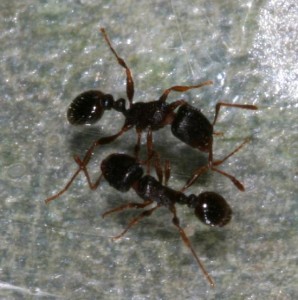

But as ants dig, removing one grain of soil at a time, the chains end up rearranged around the outside of the tunnel (right) Before soil is disturbed by ants, force chains tend to be rather randomly patterned (as pictured left). The team also found that the ants subtly change the force chains in the earth through which they dig as they extend their tunnels. 'It turns out that by removing grains in this pattern that we observed, the ants benefit from these circumferential force chains as they dig down.' 'It's been a mystery in both engineering and in ant ecology how ants build these structures that persist for decades,' explained Professor Parker. In fact, it is this that gives the tunnel walls their stability, while also helping to relieve the pressure on the grains at the working face of the tunnel, making it easier for the ants to remove them in turn.

But as ants dig, removing one grain of soil at a time, the chains end up rearranged around the outside of the tunnel. The team also found that the ants subtly change the force chains in the earth through which they dig as they extend their tunnels.īefore soil is disturbed by ants, force chains tend to be rather randomly patterned. Pictured: the experimental setup (top left) the tunnels formed in the grains (top right and, as a volume, bottom left) and, finally, a depiction of the original positions of the grains that the ants removed (bottom right)
#Ants dig dug arrangement how to#
In their experiments, the researchers worked out how to get ants to dig in little cups of soil that could then be loaded into an X-ray scanner for analysis, allowing the team to create a three-dimensional snapshot of the tunnels the insects formed. 'We thought maybe they were tapping grains of soil - and that way they could assess the mechanical forces on them.' In the study, the team suspected that ants 'could sense these force chains and avoided digging there. In contrast, the grains (or Jenga blocks) that can't easily be removed - those bearing the weight of the material above - are said to be part of their respective structure's 'force chains', the parts that are jammed together by the forces placed on them. Specifically, the team proposed that digging ants feel around in the dirt looking for loose grains of soil that can be removed safely - just like Jenga players might seek out loose blocks that can safely be pulled out of a tower. 'We hypothesized that maybe ants were playing Jenga.' 'We didn’t interview any ants to ask if they know what they're doing, but we did start with the hypothesis that they dig in a deliberate way. 'I saw a picture of one of these next to a person and I thought "My goodness, what a fantastic structure." And I got to wondering if ants "know" how to dig. 'I got inspired by these exhumed ant nests where they pour plastic or molten metal into them and you see th ese vast tunnel systems that are incredibly impressive,' explained Professor Andrade. In their study, mechanical engineer Jose Andrade of Caltech and colleagues set out to solve the question of whether ants dig 'blindly' when excavating their nests - or if their actions are more deliberate. The findings could one day help us build robots capable of digging better human-sized tunnels, the team said, such as for mining or constructing subways. Some nests can harbour millions of individual ants and endure for decades, attesting to the durability of their design.

However, this serves to alter the forces in the surrounding soil such that it strengthens the tunnel walls while also making it easier to remove grains at its end.Įssentially miniature cities, ants' nests contain branching tunnels that link various specialised chambers, from nurseries for young to 'toilet' spaces for waste. They found that ants are really efficient tunnellers - but not knowingly. Instead, they remove only loose grains that can be taken out without the tunnel collapsing. Researchers from the California Institute of Technology (Caltech) created X-ray images of ants in cups of soil as they dug their tiny tunnels. Ants dig their intricate subterranean nests at depths of up to 25 feet underground in much the same way that humans play Jenga, a study has found.


 0 kommentar(er)
0 kommentar(er)
